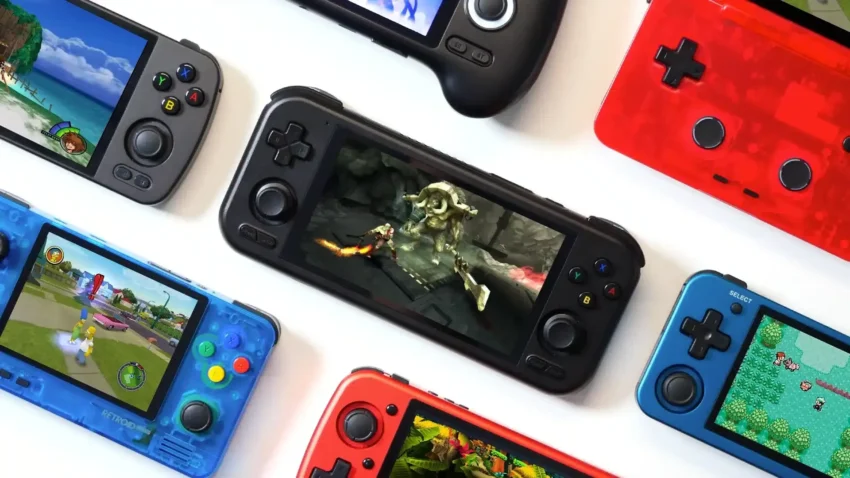Android gaming handhelds have taken the gaming world by storm, offering players a portable solution to enjoy their favorite titles on the go. However, buying Android gaming handhelds in the US has recently become a more expensive endeavor due to increased import taxes on devices and stringent gaming device tariffs. The gaming handheld market has seen a surge in popularity, but with the latest changes in US Customs fees, gamers may need to rethink their purchasing strategies. As the administration grapples with policies that impact imports from China, potential buyers must be aware of how these tariffs could affect their wallets. Navigating the complexities of customs fees and taxes could be daunting, but understanding these factors is crucial for anyone looking to invest in a gaming handheld.
Portable gaming consoles, often referred to as Android gaming devices, have gained immense traction among enthusiasts and casual players alike. The rise of these handheld gaming systems has revolutionized how we experience gaming, making it more accessible than ever. Yet, with the ongoing shifts in the gaming handheld market, including new regulations and potential import taxes on devices, consumers face a landscape that is rapidly changing. As buyers explore options in this thriving sector, they must also consider the implications of gaming device tariffs and the associated costs that come with purchasing from overseas. It’s essential for players to stay informed about the latest developments to make smart buying decisions in this dynamic environment.
The Impact of Import Taxes on Gaming Handhelds
The recent changes in the import tax regulations have significantly affected the gaming handheld market, particularly for devices sourced from China. With the introduction of formal processing fees by the US Customs and Border Patrol, consumers are now facing additional costs when purchasing gaming handhelds. These costs can include not only taxes but also flat customs fees that range from $3 to $22, depending on the package’s value. For budget-conscious gamers, these additional expenses can make previously affordable devices prohibitively expensive.
The implications of these new tariffs and fees extend beyond just the consumer. Retailers and smaller companies, especially those selling through platforms like AliExpress and Temu, will also feel the pressure. Many of these companies rely on the de minimis exemption that allowed goods under $800 to enter the US without customs inspections or fees. With this exemption on hold, the gaming handheld market could see a decline in sales as consumers reconsider their purchases in light of the added costs.
Understanding US Customs Fees and Their Effects
US Customs fees play a crucial role in the pricing of imported goods, including gaming handhelds. The recent policy changes mean that all shipments from China are now subject to formal customs processing, regardless of their declared value. This shift is significant, as it increases the operational costs for retailers and could lead to higher prices for consumers. As a result, buyers might find themselves paying much more than they anticipated for their favorite gaming devices.
Additionally, the increased scrutiny at customs can lead to delays in shipment processing, which could disrupt the supply chain for gaming handhelds. Retailers who previously enjoyed smooth shipping processes may now face logistical challenges, leading to potential stock shortages in stores. This disruption could also affect the availability of popular handheld models, making it more challenging for consumers to purchase their desired devices in a timely manner.
Navigating the Gaming Handheld Market Amid Tariffs
As consumers navigate the rapidly evolving gaming handheld market, understanding the implications of tariffs and customs fees is essential. The recent announcements have created uncertainty, leading many potential buyers to hesitate before making purchases. Retailers may need to adjust their pricing strategies to accommodate the increased costs associated with importing gaming devices, which could lead to higher retail prices across the board.
Moreover, consumers might want to explore options beyond traditional import channels. Local retailers could become more appealing as they may offer competitive prices without the added complexity of customs fees. Additionally, buying from domestic brands or retailers that source their products locally could help avoid the pitfalls associated with international shipping and tariffs. As the market shifts, it’s crucial for buyers to stay informed and consider all their options.
The Future of Gaming Handhelds in the US Market
The future of gaming handhelds in the US market remains uncertain due to the ongoing changes in import regulations. If the de minimis exemption is completely removed and tariffs remain high, it could stifle the growth of the gaming handheld market, making it difficult for new entrants to compete. Established players may also struggle as their profit margins shrink due to increased costs.
However, it’s possible that innovation will drive the market forward despite these challenges. Manufacturers may adapt by exploring alternative manufacturing locations to bypass tariffs or by offering new models that provide better value to consumers. The resilience of the gaming handheld community, combined with potential shifts in production and retail strategies, could ultimately shape the future landscape of gaming devices in the US.
Strategies for Buying Gaming Handhelds in a Changing Market
With the recent upheaval in import policies, consumers must adopt new strategies when buying gaming handhelds. One effective approach is to research and compare prices from various retailers, including local shops and online marketplaces. This will help buyers identify the best deals while factoring in potential customs fees and taxes. Additionally, staying informed about the latest updates in US Customs regulations will empower consumers to make educated purchasing decisions.
Another strategy involves considering the purchase of gaming handhelds from domestic brands or those that have established production facilities outside of China. This not only helps avoid the added costs associated with tariffs but also supports local businesses. By diversifying their purchasing options and being mindful of the implications of tariffs and fees, consumers can still enjoy the latest gaming devices without breaking the bank.
Customs Regulations and Their Effect on Gamers
The recent changes in customs regulations have created a ripple effect across the gaming industry, impacting gamers directly. With the implementation of formal processing fees, every shipment from China is now subject to scrutiny, which can lead to delays and additional costs. Gamers who are eager to get their hands on the latest handheld devices may find themselves facing unexpected expenses that can significantly alter their purchasing decisions.
Moreover, these regulations could lead to a shift in how gamers acquire their devices. Many may turn to local retailers or consider used devices to circumvent the import tax challenges. This evolution in buying behavior could reshape the gaming handheld market, as consumers become more cautious about where and how they purchase their gaming devices.
The Role of Tariffs in Shaping Consumer Behavior
Tariffs have always played a significant role in shaping consumer behavior, and the gaming handheld market is no exception. As import taxes rise, consumers are forced to reevaluate their spending habits and consider the long-term implications of purchasing imported goods. The prospect of paying hefty tariffs and customs fees can deter many from making impulsive purchases, leading to a more calculated approach to buying gaming devices.
This shift in consumer behavior could also encourage a greater focus on local products and brands. As gamers seek to avoid additional costs, there may be an increased demand for domestically produced handhelds. Companies that can offer competitive pricing without the burden of tariffs will likely see a surge in sales, as consumers become more value-conscious in light of the changing economic landscape.
The Growing Popularity of Portable Gaming Devices
Despite the hurdles presented by tariffs and customs fees, the popularity of portable gaming devices continues to grow. Gamers are increasingly drawn to the convenience and versatility offered by gaming handhelds, making them a staple in the gaming community. This trend underscores the resilience of the gaming handheld market, even in the face of economic challenges.
Manufacturers are likely to respond to this demand by innovating and improving their offerings. As competition heats up, we can expect to see advancements in technology and design that cater to the needs of gamers. Additionally, as consumer preferences evolve, companies may prioritize value and functionality, ensuring that gaming handhelds remain a popular choice for both casual and hardcore gamers alike.
Looking Ahead: What Gamers Can Expect
As we look to the future of the gaming handheld market, it’s clear that changes in import policies will continue to shape the landscape. Gamers can expect to see fluctuations in prices as retailers adjust to the new normal of tariffs and customs fees. However, this environment also presents opportunities for innovation and growth, as companies seek to overcome challenges and meet consumer demand.
Ultimately, gamers will need to stay informed and adaptable in this rapidly changing market. By understanding the implications of import regulations and tariffs, they can make smarter purchasing decisions that align with their gaming needs and budget. Whether through exploring local options or taking advantage of sales and promotions, savvy consumers can navigate the complexities of buying gaming handhelds while still enjoying their favorite devices.
Frequently Asked Questions
What are the current US Customs fees for buying Android gaming handhelds from China?
When buying Android gaming handhelds from China, the US Customs fees can vary. Currently, all shipments from China are subject to formal processing fees, which can range from $3 to $22, in addition to potential tariffs that can reach up to 30% of the declared value of the device.
How do import taxes on devices affect the gaming handheld market?
Import taxes on devices significantly impact the gaming handheld market by increasing the overall cost for consumers. With recent changes, buyers may face additional taxes and customs fees, making popular Android gaming handhelds more expensive and possibly reducing their accessibility.
What should I know about gaming device tariffs when purchasing Android gaming handhelds?
When purchasing Android gaming handhelds, be aware that gaming device tariffs can add substantial costs. Recent tariffs imposed on goods from China can reach up to 30%, meaning that the price you see online may not reflect the final price after customs fees and tariffs are applied.
Are there any changes to the buying process for gaming handhelds due to US Customs regulations?
Yes, recent changes in US Customs regulations have affected the buying process for gaming handhelds. All imports from China are now subject to formal processing fees and potential tariffs, which may delay shipping and increase costs for buyers.
What are the implications of the de minimis exemption removal for Android gaming handhelds?
The removal of the de minimis exemption means that previously duty-free shipments under $800 are now subject to customs fees and tariffs. This change will likely increase the prices of Android gaming handhelds and could deter buyers from purchasing them from overseas.
How can I avoid high customs fees when buying Android gaming handhelds?
To avoid high customs fees when buying Android gaming handhelds, consider purchasing from domestic retailers or platforms that operate within the US. Alternatively, be aware of the total cost including potential tariffs and customs fees when importing from international sellers.
What are the best practices for importing Android gaming handhelds to minimize import taxes?
To minimize import taxes when importing Android gaming handhelds, research the current tariffs and customs fees, consider buying from sellers with lower declared values, and stay informed about any changes in import regulations that could affect your purchase.
Will the recent changes in import policy impact the availability of Android gaming handhelds?
Yes, the recent changes in import policy could impact the availability of Android gaming handhelds. With increased tariffs and customs fees, some sellers may opt to limit shipments to the US, potentially reducing the variety and stock available to consumers.
Is it worth buying Android gaming handhelds from overseas given the new Customs fees?
Whether it’s worth buying Android gaming handhelds from overseas depends on the total cost, including shipping, customs fees, and tariffs. If the overall price remains competitive compared to domestic options, it may still be a viable choice.
How do changes in tariffs affect the prices of popular gaming handhelds?
Changes in tariffs can lead to higher prices for popular gaming handhelds, as manufacturers may pass on the costs of tariffs and customs fees to consumers. This could affect the affordability and accessibility of these devices in the gaming market.
| Key Point | Details |
|---|---|
| Increased Costs for Imports | The removal of the de minimis exemption means lower-value imports from China will now be subject to tariffs and customs fees. |
| Impact on USPS | The USPS has temporarily suspended international package acceptance for inbound parcels from China and Hong Kong. |
| Effect on Gaming Handhelds | Most gaming handhelds are manufactured in China, meaning they will be affected by new tariffs and customs policies. |
| Tariff Estimates | Buyers may face tariffs of up to 30% plus additional customs fees ranging from $3 to $22. |
| Political Backdrop | This situation stems from a recent executive order by President Trump, which implements new tariffs and customs regulations. |
| Market Impact | The new regulations could significantly harm the growing market for cheap handhelds, potentially leading to higher prices. |
Summary
Android gaming handhelds are facing a challenging landscape due to recent changes in import policies that have made buying them in the US more expensive. With the removal of the de minimis exemption, many lower-value imports from China are now subject to tariffs and additional customs fees. The gaming handheld market, which has seen substantial growth, could be severely impacted as prices rise and availability dwindles. This situation highlights the delicate balance between international trade policies and consumer access to affordable gaming technology.






